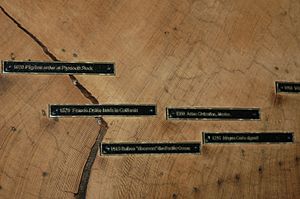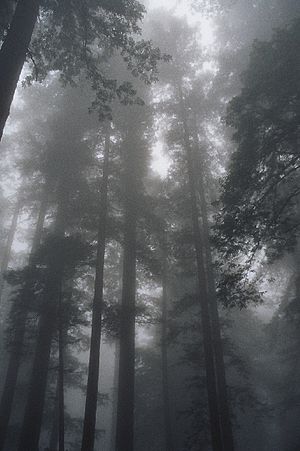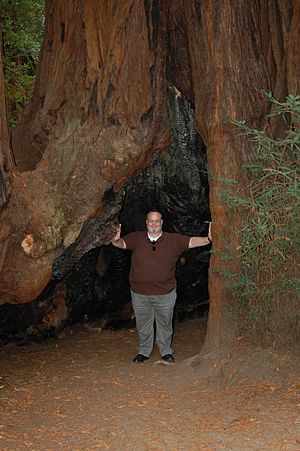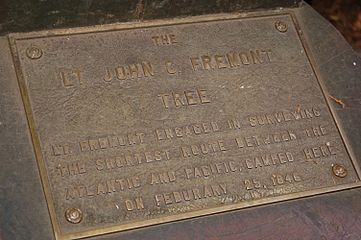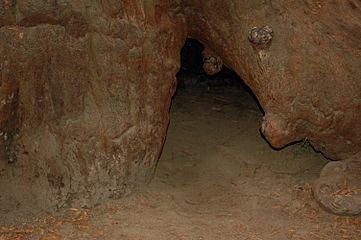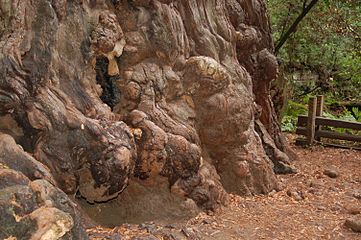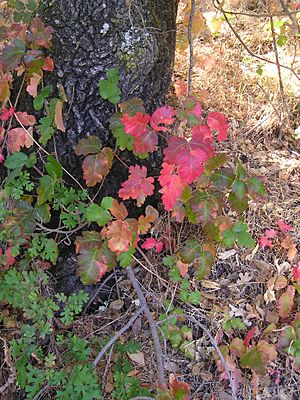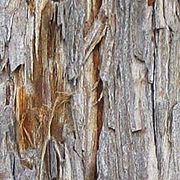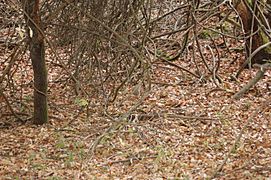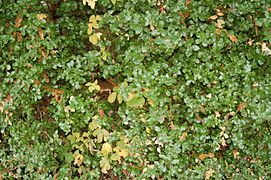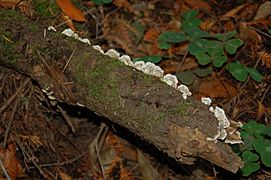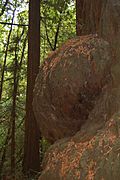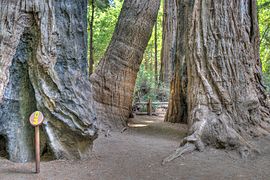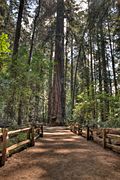Redwood Grove facts for kids
The Redwood Grove is a special part of Henry Cowell Redwoods State Park in Santa Cruz County, Northern California. It's home to giant Coast Redwood trees, some of which are 1,400 to 1,800 years old! You can explore this amazing grove on a self-guided tour along a flat, 0.8-mile (1.3 km) loop trail. It's super easy to get to, just 150 feet (46 m) from the parking lot. Many huge, ancient redwood trees stand right next to the path.
Contents
About Coast Redwoods
Coast Redwoods (Sequoia sempervirens) naturally grow in the deep valleys and lower to middle parts of the Santa Cruz Mountains. They love areas close to the ocean because of the heavy rain, cool air, and fog. The fog helps keep them moist. They also thrive in dimmer sunlight near their bases and need streams that flow all year.
The bark of these huge trees is full of a substance called tannin. This tannin helps protect the trees from fires and insects. It's like a natural shield!
Why This Grove is Special
This particular grove has some of the tallest and oldest trees in Henry Cowell Redwoods State Park. This is because the park protects the natural environment. They don't clear the plants growing under the trees, and no logging is allowed. When trees fall or are hit by lightning, they are left to decay naturally. This creates a rich environment full of nutrients, which helps the soil stay healthy even with lots of rain.
In these old-growth forests, you can see new redwood trees starting from shoots and burls. You can also see the remains of ancient trees, like "fairy rings," which show where old trees once stood. Many of these giant redwoods were born even before the Battle of Hastings in 1066!
All the native plants and animals that have lived in these mountains for centuries are allowed to stay. This even includes poison oak plants, which can cause an itchy rash.
History of the Area
This part of the California coast was once home to the Awaswas people, a group of Ohlone Native Americans.
Spanish Exploration and Missions
In 1769, a Spanish explorer named Gaspar de Portolà camped by the San Lorenzo River. He placed a wooden cross there to mark the spot for Spain. This exploration led to the Catholic Friars coming to the area. Their goal was to convert the native people to Catholicism.
Just over 20 years later, in 1791, a Catholic mission called Mission Santa Cruz was built nearby. This mission was a place where native people were taught about Catholicism. From 1805 to 1812, Father Andrés Quintana ran the mission. He was one of only two Spanish missionaries who were killed for their beliefs in Alta California.
Mexican and American Control
After Mexico became independent from Spain in 1821, it took control of this area. This lasted until the land became part of the United States in 1846. During Mexican rule, the government often gave out large land grants to people they favored. Big parts of this untouched forest became grants like Rancho Carbonera, Rancho Zayante, and Rancho Cañada del Rincon en el Rio San Lorenzo. These land grants were the start of European settlement in what is now Henry Cowell Redwoods State Park.
In 1843, the Mexican Government gave a French immigrant named Pedro Sainsevain a huge piece of land, about 8,800 acres (35.6 km2). This land was called Rancho Cañada del Rincon en el Rio San Lorenzo de Santa Cruz. This grant included what we now know as Henry Cowell Redwoods State Park. After a few changes of ownership over about 20 years, the land ended up with Henry Cowell.
Exploring the Grove Trail
Coastal Zone Environment
Coast Redwoods grow very well in this cool, foggy environment. It's the perfect place for them because it's moist, a bit dim, and far enough from the ocean that there's no salt in the air.
The Red Color of Redwood Trees
These trees have a lot of tannic acid in their bark, which gives them their reddish color.
Fire Resistance
The high amount of tannic acid in the wood and bark, along with the bark's thickness (6-12 inches or 15-30 cm), helps redwoods resist natural and human-caused fires. The thick bark protects the living growth layer, allowing the tree to heal after damage.
Other Tree Species
You'll often see Douglas Firs growing among the Coast Redwoods. They are also well-suited to this kind of environment.
Circular Tree Groups
You might notice "Fairy Rings" and "Cathedral Groups" in redwood forests. These show how amazing redwoods are at growing back! When a tree dies, many new trees often grow in a circle around its decaying center. This happens because new shoots grow from the original tree's burls and roots. The open space where the old tree stood allows enough sunlight for the new trees to grow.
Decaying Trees
Since this is a protected area, trees that fall to the ground are left to decay. They provide shelter for insects and add more nutrients to the soil for the other living trees.
The Tallest Tree
The biggest tree in this grove is about 280 feet (85 m) tall! To support such a height, its base is over 17 feet (5.2 m) wide.
The Fremont Tree
There's a famous story about the Fremont Tree. In 1846, Lieutenant John C. Fremont and his group were exploring California. They supposedly camped overnight inside the burned-out base of this tree. The inside is larger than a typical army tent from the 1840s, so it would have been a great shelter for several adults. When asked about the story in 1888, Fremont reportedly said, "It makes a great story, let it stand."
Burls
Burls are wart-like bumps that appear on the sides of redwood trunks and roots. They are part of the tree's growth layer. Small shoots often grow from these burls and roots, which can lead to many new trees growing over time. This helps the forest grow back.
Hazards in the Grove
Poison oak is a plant that naturally grows on the ground in the Santa Cruz Mountains. It's easiest to spot when its leaves change to a reddish color, but for most of the year, you can only recognize it by the shape of its lobed leaves. This makes it more dangerous if you're not careful!
The park does not remove any poison oak plants from this grove. This is part of their promise to keep the area as natural as possible.
Images for kids
-
A close-up view of Coast Redwood bark.
-
Natural ground cover with Tanoak and Bay leaves, plus poison oak.
-
A patch of Holly mixed with poison oak plants.
-
Bracket fungus growing on a decaying Douglas Fir log, with Redwood Sorrel plants.
-
A burl on a Coast Redwood tree that's as big as a refrigerator!
-
Natural undergrowth with California Bay and Coast Redwood trees.
-
A person standing next to a very large Coast Redwood tree.


